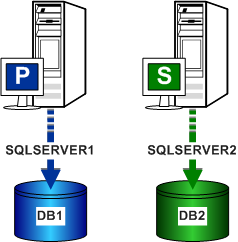When you set up the same database on the primary and secondary server (so you will have two actual databases that, under normal operation, will be identical) you need to identify them for data logging.
|
Redundancy configuration overview. |
|
|
Redundancy configuration steps. |
Redundancy Configuration Overview
In a redundant configuration:
![]() The primary and secondary servers
log data in parallel to their own
database.
The primary and secondary servers
log data in parallel to their own
database.
![]() The primary server logs to the
database on the primary SQL Server.
The primary server logs to the
database on the primary SQL Server.
![]() The secondary server logs to the
database on the secondary SQL Server.
The secondary server logs to the
database on the secondary SQL Server.
The only time the primary or secondary server will connect to the other node's database is when the data on the two servers needs to be merged.
![]() The CIMPLICITY server redundancy
operation requires that the:
The CIMPLICITY server redundancy
operation requires that the:
![]() Primary server be aware of the
secondary SQL Server
Primary server be aware of the
secondary SQL Server
![]() Secondary server be aware of the
primary SQL Server
Secondary server be aware of the
primary SQL Server

|
P |
= Primary Server |
|
S |
= Secondary Server |
Redundancy Configuration Steps
In logged database redundancy, configure CIMPLICITY server redundancy, on both the primary and secondary server, through Windows Control Panel..
|
Configure the Windows ODBC Data Source Administrator |
|
|
Identify the Database Logger data source in a CIMPLICITY project. |
|
Server redundancy configuration procedures. |